

Trouw Nutrition India carries out analysis of mycotoxins in samples from Pan-India to

Mycotoxin Outlook (2021) for the Indian region covers an overview of the mycotoxin distribution and its concentration in various feeds, raw materials, and species risk assessments. A total of 1203 samples were analysed and taken into consideration for this report.
The tables (1&2) give a summary of mycotoxin concentrations in various feeds and raw materials.

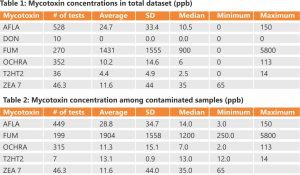


In terms of contamination percentage, samples tested for zearalenone showed 100% contamination, followed by ochratoxin, aflatoxin, and fumonisins at 89, 85, and 74% contamination, respectively (depicted in Fig. 1 below). T2HT2 showed the least 19% contamination amongst the various samples tested.
Mycotoxin Incidence in different types of raw materials and feedstuffs in different regions of India

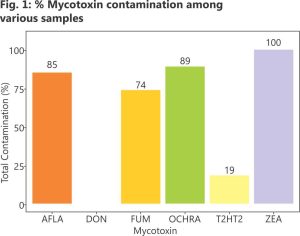

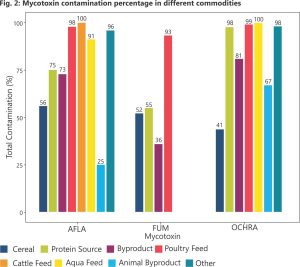


In broiler feeds, the maximum levels of aflatoxin reached 144 ppb and 117 ppb in layer feeds. The average value for aflatoxin in broiler and layer feeds were 26 and 16 ppb, respectively, indicating high and medium risk, respectively. The highest ochratoxin levels were at 104 ppb in broiler feeds and at 66 ppb in layer feeds. The median values for both the feeds (12 and 9 ppb) indicated a low-risk level for poultry. Fumonisins had almost similar high concentrations in the broiler (5800 ppb) and layer (5400 ppb) feeds, with the average values indicating low risk to poultry. Zearalenone and T2HT2 analysis was lower as such for the number of samples analysed and indicated lower contamination levels in the samples tested.

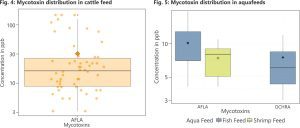
Of the various samples analysed in ruminant feeds, the highest concentration recorded was 150 ppb of aflatoxin, with an average value of 31 ppb, indicating a very high risk for dairy cattle, and its highest probability of M1 concentrations in milk (as AfM1).

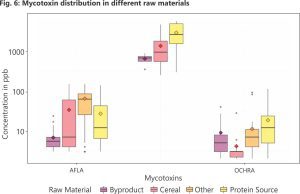
Although the number of samples tested for mycotoxins was low for aquafeeds, the contamination percentage was quite high and ranged from 100% to 83% for aflatoxin in fish and shrimp feeds, respectively.
Mycotoxin Incidence in different Raw materials in India
Aflatoxins and Fumonisins presence were majorly seen in cereal grains followed by the protein sources, with the minimal occurrence being in cereal by-products. The highest percentile of aflatoxin was also evident in other categories, which majorly constituted the groundnut cake. In contrast to aflatoxin, ochratoxins were majorly seen in protein sources, others, and cereal by-products, with the least being in cereals.

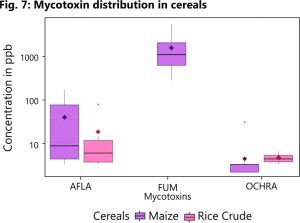
In cereals, aflatoxins and fumonisins were majorly seen in maize, with average concentrations of 50 and 2500 ppb, respectively. Amongst protein sources, aflatoxin prevalence was highest in sunflower meal, with the highest concentration being in maize gluten meal. 
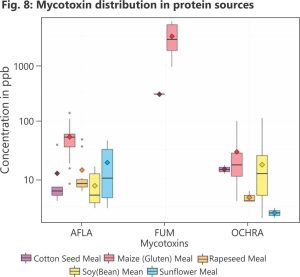

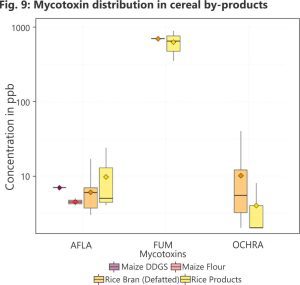


Mycotoxins present a permanent challenge for the animal industry because they are widely present in almost all the feedstuffs used in feed production and may affect animal production even in very low concentrations. Fluctuations in animal performance are relatively common, especially in poultry and these are frequently inexplicable. Sudden losses in feed conversion, as well as in other performance parameters could be attributed to mycotoxin contaminated feeds. Aflatoxin effects carry public health importance in dairy, wherein other than the compromise of animal performance, there is a high risk of carcinogenic implications to humans, consequent to carry-over of AFM1 in milk. An integrated holistic approach needs to be adopted to evade the mycotoxin challenge in animals. One of the strategies is the inclusion of good quality mycotoxin binders regularly in feed at sufficient dosage to combat the effects of mycotoxins in animals, depending on the mycotoxin contamination levels and their types. The majority of mycotoxins have a negative impact on immunity and intestinal integrity. The addition of a broad-spectrum toxin binder, in these scenarios, will aid in protecting the gut integrity and boosting up the immunity of the animal. Rapid, robust, and accurate analysis of different mycotoxins at the field level, will provide a quick judgment of the quality of raw material and finished feed and enable the producer to take quick decisions effectively.
Abbreviations used in the analysis
AFLA: Aflatoxins; DON: Deoxynivalanol; FUM: Fumonisins; OCHRA: Ochratoxins; T2HT2: T2 and HT2 Toxin; ZEA: Zearalenone
For further information, you may write to customercareindia@trouwnutrition.com
by By Avinash Bhat, Dr. Rajesh Pittala & Dr. Sabiha Kadari, Trouw Nutrition India













